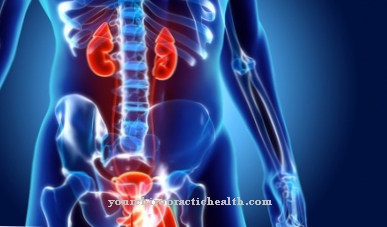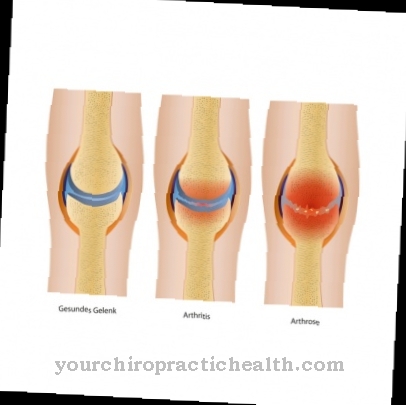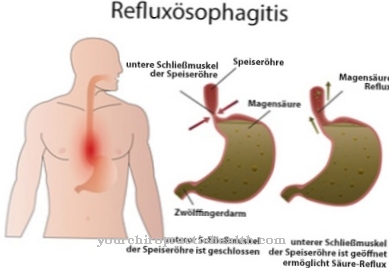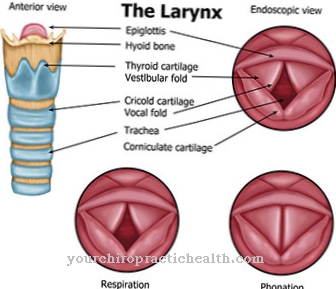At the CHIME syndrome it is a disease that is comparatively rare. In addition, the affected patients are mostly mentally handicapped.
What is CHIME Syndrome?

© olive1976 - stock.adobe.com
The CHIME syndrome is synonymous in some cases as neuroectodermal syndrome or Zunich-Kaye syndrome designated. The prevalence of the disease is estimated at around 1: 1,000,000. In principle, the CHIME syndrome is inherited to subsequent generations via an autosomal recessive route.
The name of the disease is an acronym. CHIME syndrome has a genetic component and is present from birth. The main symptoms include coloboma on both sides, wandering dermatosis, seizures, hearing loss due to deformities of the ears, and defects in the heart.
The main symptoms of the disease include colobomas, heart defects, as well as abnormalities of the face. The disease was first described in 1983 by Zunich and Kaye. In honor of these two authors, the name CHIME syndrome was introduced. The dermatosis that occurs as part of CHIME syndrome migrates and manifests itself either from birth or within the first four to six weeks.
causes
The CHIME syndrome is primarily based on genetic causes. Special mutations are responsible for the fact that the affected patients have defects in a certain gene. As a result, the CHIME syndrome develops. Specifically, these are mutations that take place in the so-called PIGL gene. CHIME syndrome is usually passed on in an autosomal recessive manner.
You can find your medication here
➔ Medicines for eye infectionsSymptoms, ailments & signs
When a person suffers from CHIME syndrome, various ailments and symptoms arise. In individual cases, they differ in part. However, craniofacial abnormalities or anomalies in the face of the affected patient are typical.
For example, mongoloid eyelids, a brachycephalus, a weakly pigmented iris and a philtrum are possible. These symptoms of CHIME syndrome may be accompanied by a flat face, hypertelorism, and a relatively wide mouth. The upper lip is usually relatively thin and narrow.
In some people with CHIME syndrome, the nostrils face forward. In numerous cases, abnormalities and deviations can also be seen in the area of the teeth. The teeth are often further apart, so that clear gaps form.
In addition, the individual teeth often have a square shape. In addition, some patients affected by CHIME syndrome suffer from defects of the heart, a cleft palate or a so-called funnel chest. In addition, some people have superfluous nipples.
However, one of the central symptoms of CHIME syndrome is migratory dermatosis. This begins at an early stage. In addition, there are usually colobomas that occur on both sides. In addition, cerebral seizures are possible. The sick people are mentally handicapped in numerous cases.
The development of language skills in patients suffering from CHIME syndrome is often delayed. Some affected people also exhibit behaviors reminiscent of autism. Some sick children also show aggressiveness, which may result in violence against others and themselves. This phenomenon usually worsens during puberty.
Diagnosis & course
The diagnosis of CHIME syndrome is made taking into account the characteristic complaints. In any case, a doctor should be consulted if there are typical signs of illness. The first priority is to take an anamnesis. The affected patient or his / her legal guardian explain the symptoms to the treating doctor and explain the living conditions in detail.
Due to the hereditary component of the CHIME syndrome, the family history must also be carried out in great detail. In this way, the doctor collects a large number of relevant pieces of information which, under certain circumstances, lead him to make a suspected diagnosis. When the patient interview is over, it's time for clinical examinations.
The focus now is on the specific symptoms of the disease. If the respective patient shows the typical combination of a wandering dermatosis, bilateral colobomas, heart defects and abnormalities of the face, the CHIME syndrome can be diagnosed with relative certainty. The diagnosis is supported by genetic analyzes that indicate mutations.
Early diagnosis is particularly important with regard to heart defects and neurological problems so that adequate treatment is prescribed.
Complications
In most cases, the CHIME syndrome leads to an intellectual disability in the patient. It is not uncommon for those affected to rely on the help of other people or carers in their everyday life and are no longer able to carry out many everyday activities themselves. As a rule, the syndrome also causes various deformities and abnormalities in the face.
These abnormalities can lead to teasing or bullying, especially in children, which can lead to mental disorders. A heart defect also occurs which, if left untreated, can lead to patient death. Most of those affected also suffer from a so-called cleft palate and a funnel chest. The quality of life is severely restricted by the symptoms of CHIME syndrome.
In most cases, the parents also suffer from psychological problems. Patients also have speech disorders and are often irritable or slightly aggressive. A causal treatment of the CHIME syndrome is usually not possible. For this reason, only the symptoms are treated, although seizures, for example, cannot be completely ruled out. Life expectancy is reduced by the syndrome.
When should you go to the doctor?
If skull deformations, abnormalities in the teeth, and other signs of CHIME syndrome are noticed, a doctor should be consulted. Parents who notice symptoms in their child should inform the pediatrician.
In the event of secondary symptoms such as the so-called funnel chest, a cleft palate or signs of a heart defect, a doctor must be consulted immediately, who can clarify the symptoms and, if necessary, treat them directly. If there is a medical emergency and the child can no longer breathe or show the first signs of a heart attack, for example, the emergency doctor should be called immediately.
Since the CHIME syndrome is a hereditary disease, a specific diagnosis is possible. If one parent is already affected by the disease or there are cases of similar diseases in the family, an examination should be carried out during pregnancy. Usually the disease is diagnosed after birth at the latest. Treatment is then usually started immediately. In later life, therapeutic and physiotherapeutic help should be sought.
Doctors & therapists in your area
Treatment & Therapy
There are several options available to treat CHIME syndrome. Therapy of the causes is impractical because it is a congenital disease. Instead, the focus is on treating the individual complaints.
Dermatosis, for example, is treated with the active ingredient isotretinoin. This reduces the damage to the skin in the majority of cases. However, there is still a risk of secondary infections. Previous observations allow a prognosis for the CHIME syndrome. So it is assumed that the general health of the affected
Patient with appropriate therapy is good according to the circumstances. However, the intellectual disability is severe and does not improve in the course of life. The wandering dermatosis is chronic and can only be alleviated with medication. The seizures also remain part of the disease.
Outlook & forecast
CHIME syndrome is usually associated with an intellectual disability that cannot be treated. There is no complete cure in this syndrome, so patients will always need symptomatic treatment throughout their lives. Furthermore, most patients are dependent on the help of other people in their everyday life.
The damage to the skin in CHIME syndrome can be limited with the help of medication. However, those affected must continue to protect themselves from infections and inflammation. The seizures are also only treated symptomatically. In the worst case, however, they can lead to the death of the person concerned if they are not resolved in time.
In the case of mental retardation, there is only a very limited healing, as this can be alleviated by various therapies and exercises. It usually does not increase in the course of life. Furthermore, in many cases, the CHIME syndrome is also associated with severe psychological complaints, which can also occur with the parents or relatives.
The treatment usually does not have a negative impact on the patient's life expectancy. If the syndrome is not treated, the patient will suffer from severe skin complaints. It cannot be universally predicted whether this will result in a reduced life expectancy.
You can find your medication here
➔ Medicines for eye infectionsprevention
According to the current state of knowledge, the CHIME syndrome cannot be prevented. Because the disease exists from birth and is inherited. Early diagnosis and therapy improve the quality of life.
You can do that yourself
People who have CHIME syndrome can do a few things themselves to improve their wellbeing. Depending on the type and severity of the disease, the CHIME syndrome itself can also be treated with natural remedies. In addition, any side effects can be supported by general measures.
The psychological complaints associated with the condition are best dealt with in a conversation with other affected persons. If necessary, the doctor can also put you in contact with a self-help group and give further tips for the supportive treatment of any emotional complaints.
Physical ailments such as the typical facial abnormalities are treated surgically. Here rest, bed rest and other typical general measures apply. In addition to conservative treatment using isotretinoin, alternative means can also help against skin changes. In consultation with the dermatologist, natural remedies such as ginseng or aloe vera can be used.
Home remedies such as cooling and warming pads can also help, depending on the type and severity of the symptoms. In order to avoid complications, appropriate means should only be used if the doctor is expressly okay.
If unusual symptoms arise during therapy, the treatment must be stopped immediately. It is appropriate to inform the doctor about the side effects.









.jpg)



.jpg)



.jpg)







.jpg)


